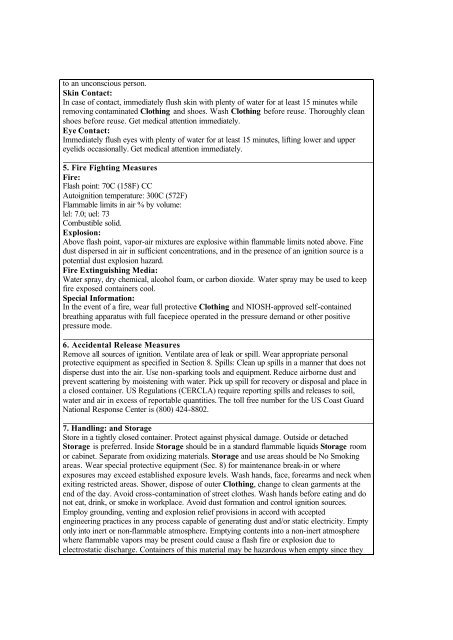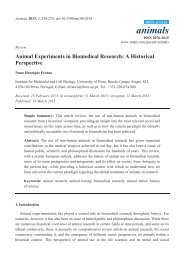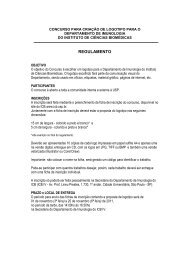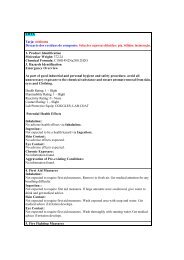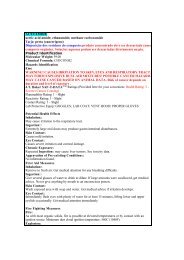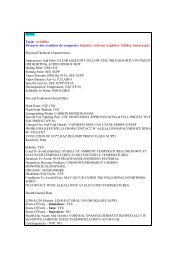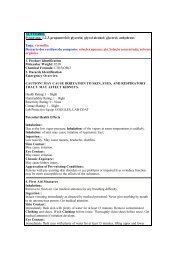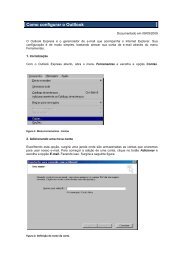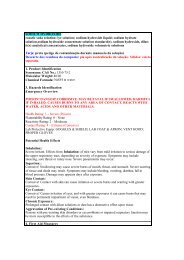PARAFORMALDEHYDE Synonyms: Polyoxymethylene ... - USP
PARAFORMALDEHYDE Synonyms: Polyoxymethylene ... - USP
PARAFORMALDEHYDE Synonyms: Polyoxymethylene ... - USP
Create successful ePaper yourself
Turn your PDF publications into a flip-book with our unique Google optimized e-Paper software.
to an unconscious person.<br />
Skin Contact:<br />
In case of contact, immediately flush skin with plenty of water for at least 15 minutes while<br />
removing contaminated Clothing and shoes. Wash Clothing before reuse. Thoroughly clean<br />
shoes before reuse. Get medical attention immediately.<br />
Eye Contact:<br />
Immediately flush eyes with plenty of water for at least 15 minutes, lifting lower and upper<br />
eyelids occasionally. Get medical attention immediately.<br />
5. Fire Fighting Measures<br />
Fire:<br />
Flash point: 70C (158F) CC<br />
Autoignition temperature: 300C (572F)<br />
Flammable limits in air % by volume:<br />
lel: 7.0; uel: 73<br />
Combustible solid.<br />
Explosion:<br />
Above flash point, vapor-air mixtures are explosive within flammable limits noted above. Fine<br />
dust dispersed in air in sufficient concentrations, and in the presence of an ignition source is a<br />
potential dust explosion hazard.<br />
Fire Extinguishing Media:<br />
Water spray, dry chemical, alcohol foam, or carbon dioxide. Water spray may be used to keep<br />
fire exposed containers cool.<br />
Special Information:<br />
In the event of a fire, wear full protective Clothing and NIOSH-approved self-contained<br />
breathing apparatus with full facepiece operated in the pressure demand or other positive<br />
pressure mode.<br />
6. Accidental Release Measures<br />
Remove all sources of ignition. Ventilate area of leak or spill. Wear appropriate personal<br />
protective equipment as specified in Section 8. Spills: Clean up spills in a manner that does not<br />
disperse dust into the air. Use non-sparking tools and equipment. Reduce airborne dust and<br />
prevent scattering by moistening with water. Pick up spill for recovery or disposal and place in<br />
a closed container. US Regulations (CERCLA) require reporting spills and releases to soil,<br />
water and air in excess of reportable quantities. The toll free number for the US Coast Guard<br />
National Response Center is (800) 424-8802.<br />
7. Handling: and Storage<br />
Store in a tightly closed container. Protect against physical damage. Outside or detached<br />
Storage is preferred. Inside Storage should be in a standard flammable liquids Storage room<br />
or cabinet. Separate from oxidizing materials. Storage and use areas should be No Smoking<br />
areas. Wear special protective equipment (Sec. 8) for maintenance break-in or where<br />
exposures may exceed established exposure levels. Wash hands, face, forearms and neck when<br />
exiting restricted areas. Shower, dispose of outer Clothing, change to clean garments at the<br />
end of the day. Avoid cross-contamination of street clothes. Wash hands before eating and do<br />
not eat, drink, or smoke in workplace. Avoid dust formation and control ignition sources.<br />
Employ grounding, venting and explosion relief provisions in accord with accepted<br />
engineering practices in any process capable of generating dust and/or static electricity. Empty<br />
only into inert or non-flammable atmosphere. Emptying contents into a non-inert atmosphere<br />
where flammable vapors may be present could cause a flash fire or explosion due to<br />
electrostatic discharge. Containers of this material may be hazardous when empty since they


